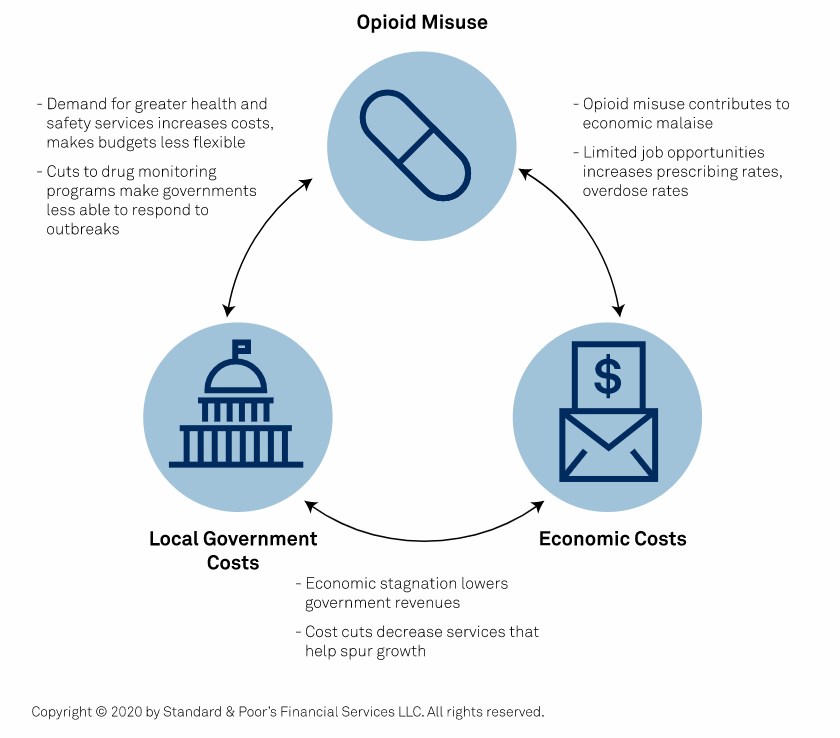It’s widely seen in communities with a widespread opioid dependency or other substance abuse that local and state governments are not only forced to stretch their already thin revenue source, but the greater need for health and safety services aren’t able to be adequately provided. These challenges have been exacerbated during the current pandemic.
In recently published data from the Centers for Disease Control (CDC), prescribed and synthetic drug overdose deaths have accelerated during COVID-19. It states, “Over 81,000 drug overdose deaths occurred in the United States in the 12 months ending in May 2020, the highest number of overdose deaths ever recorded in a 12-month period.”
In this article, we will take a closer look at the inverse relation between the opioid crisis and the economic prosperity of local governments.
Be sure to check out our Education section to learn more about municipal bonds.
Opioid Crisis Paired with a Pandemic
Although the majority of federally sponsored health and care services are typically run and funded by their respective state governments, local governments are the first line of defense in combating the challenges arising from either one of the health crises (i.e.,public safety, realignment of resources for housing, criminal justice expenditure related to the increase, and other critical services needed for the at-risk population). The recently published report by Standard and Poor highlights that, “The current opioid drug epidemic continues to demand spending from local governments that may be struggling to maintain structural budgetary balance amid the pressures resulting from COVID-19. Moreover, leading research has linked high rates of opioid abuse with regional economic declines, including through lower labor force participation rates.”
Furthermore, the economic costs of the opioid crisis were already insurmountable. However, as more and more employers are starting to hire workforces, it may be difficult to find the labor force participation to meet the demand, taking a significant toll on the economic output for local and regional economies. As an example, in 2018 the Federal Reserve Bank of Cleveland reported that “businesses it surveyed reported difficulty finding qualified employees due to candidates’ inability to pass drug tests.”
Quantifying the Impacts on Local Government Operations
- The drug abuse leads to increase in other crimes, which leads to net population outflow, which leads to deterioration of property valuations, eventually leading to a drop in property tax revenues for all levels of governments.
- The inability or unwillingness to participate in suitable employment leads to loss in tax revenues, as well as deterioration of retail sales that generate sales tax revenues.
- The local governments still have the same burden to provide adequate levels of public safety and services; however, with the added strain on already thin revenues, the services are often cut to balance the budgets.
- Another primary driver of local government revenues are small and mid-sized businesses and their presence in local economies for providing jobs. Due to the aforementioned challenges, you’d often see relocation of businesses and/or closing down due to lack of business viability.
Be sure to read this article to know the implications of COVID-10 led exodus.
The below diagram illustrates how local economies deteriorate due to opioid misuse:

The Bottom Line
For investors in municipal debt, the opioid crisis and its prevalence is viewed as a significant credit risk.
Sign up for our free newsletter to get the latest news on municipal bonds delivered to your inbox.
Disclaimer: The opinions and statements expressed in this article are for informational purposes only and are not intended to provide investment advice or guidance in any way and do not represent a solicitation to buy, sell or hold any of the securities mentioned. Opinions and statements expressed reflect only the view or judgement of the author(s) at the time of publication and are subject to change without notice. Information has been derived from sources deemed to be reliable, the reliability of which is not guaranteed. Readers are encouraged to obtain official statements and other disclosure documents on their own and/or to consult with their own investment professionals and advisers prior to making any investment decisions.

